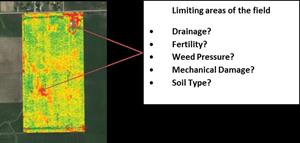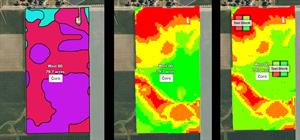AGRONOMIC RESOURCESTO SUPPORT EVERY SEASON
YOU CAN TAKETO THE FIELD
Variable Rate Seeding
Across the Corn Belt, we do a great job producing a successful corn and soybean crop. However, when we study yield data in the fall, we find areas in the field that are less productive than others. Over the past few years, farmers have studied this variability and have considered variable rate seeding (VR) as a solution to solve this problem. This article discusses management practices as well as a guide to implementing variable rate seeding recommendations on your farm.
Theory behind Corn and Soybean Variable Rate Seeding
The goal for variable rate seeding is to optimize population rates in the entire field to maximize the RIO of every acre. The basic principle, for corn, is that in the areas of higher productivity, we want to increase population, and in lower productivity environments, we want to lower population. Management practices, soil characteristics, hybrid selection and weather are the primary factors that can determine productivity across any given field.
Variable rate seeding of soybeans is relatively new and has a lot of interest. VR seeding recommendations for soybeans should look inversed compared to corn. In higher productivity environments, we want to lower seeding rates due to the soybeans ability to branch out and grow more pods. In low productivity environments, we want to increase seeding rates since they have less ability to branch out and tend to be shorter. Seed treatments, row width and maturity also play a role in seeding rates.
Equipment Needed
Today, there are a lot of planters on the market that can execute variable rate seeding prescriptions. Most of the new planters are standard with the technology. Equipment needed includes GPS guidance to track location, a monitor that can import a VR recommendation, and, a planter with rate control automation.
Steps to Implement VR
- Study your fields and their history. A good place to start is yield maps and general field knowledge. Identifying limiting factors in your fields is also important. If there are areas that need attention (drainage, fertility, etc.) it is important to fix and address those issues first since they can give you a good ROI, and eliminate a yield limiting variable. I like to look at VR seeding as “icing on the cake” and being one of the last things we do.

- Once other variables have been addressed, it is time to create management zones. There are many ways to create management zones and a lot of programs to help. Some of the ways growers create management zones is by yield data, SURGO maps, Irrigation pivots, soil test data, and other methods. There are pros and cons to each method depending on the quality of data. Advantage Acreâ uses Functional Soil Mapping technology to create management zones in the field. Functional Soil Mapping looks at soils 3-dimensionally to see how soils are changing based on slope, topography, and water movement. Utilizing multiple tools can be helpful when creating management zones.

- Working with your seed provider is the next step to creating your VR seeding recommendation. When choosing hybrids, you should first look at products that fit your needs for each field. Maturity, stalk/root strength, agronomics, health package, and yield potential are all important. Each product also responds differently to soil characteristics and population. Make sure you have these conversations. Additionally, Advantage Acre® utilizes AgReliant Genetics’ research on each product to effectively understand the optimum population for each hybrid to achieve maximum yield.
- The final step is to execute your seeding recommendation. It is important to add testing strips or blocks to evaluate the effectiveness of the prescription. When adding these tests, you should find areas of the field that will give you consistency for a good comparison. Looking at soil type and elevation are a good start. The test block feature in Advantage Acre makes it very easy to test if the optimal seeding rate was used in different areas of the field and continue to optimize seeding rates on each field of your farm.
Payout
Payout is something every grower wants to know when trying a new product or practice on their farming operation. Variable rate seeding is a practice we do not hear much about regarding ROI. The main reason we do not hear this is because the return is dependent on the amount of variability in each field. For example, if we have a field that has similar highly productive soils, we would rarely see an advantage to VR seeding. However, if we have a field with different soil types (Clay loam, Silty clay loam, Silt loam) we would expect to see a more positive ROI.
If you are a farmer considering VR seeding for the first time, the suggestion would be to choose fields with the most variability and use test strips or blocks and evaluate at the end of the year. Programs like Advantage Acre® have helped take a lot of “guess work” out of the equation, but it still may take a few seasons to get it right.
Summary
Variable rate corn and soybean seeding is a practice that has gained popularity over the past few years due to research and technology advancements. Before implementing VR seeding, it is important to carefully review each field and work with your seed provider to understand field variability and hybrid management. With field variability and proper management, variable rate seeding can be a profitable practice for your farm. If you have any questions about variable rate seeding or Advantage Acre, contact your local Area Sales Manager or Agronomist.
Resources
http://www.cornandsoybeandigest.com/precision-ag/make-variable-seeding-work
https://www.striptillfarmer.com/articles/1092-variable-rate-technology-plants-seeds-of-profitability
https://www.topcropmanager.com/precision-ag/bmps-for-variable-rate-planting-20783
www.advantageacre.com
Note: The information in this issue is based upon field observations and third party information. Since variations in local conditions may affect the information and suggestions contained in this issue, LG Seeds disclaims legal responsibility therefore. Always read and follow label instructions.
Advantage Acre® is a registered trademark of AgReliant Genetics, Inc.
LG Seeds® and design are trademarks of AgReliant Genetics, LLC.





Technical Team Agronomist